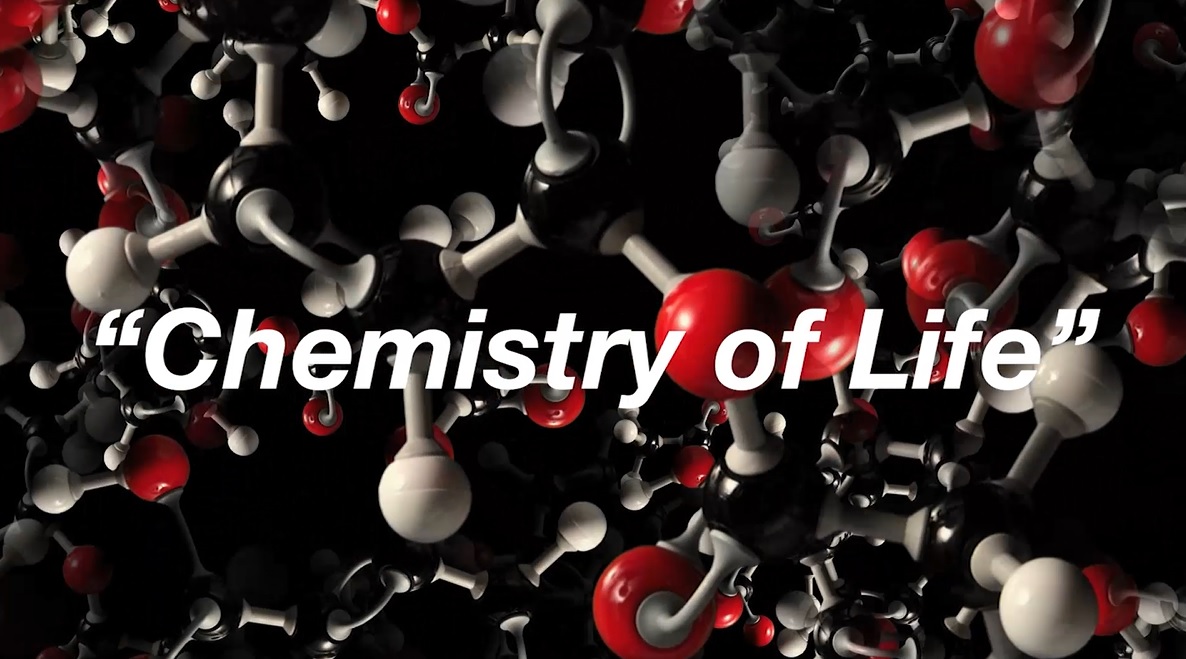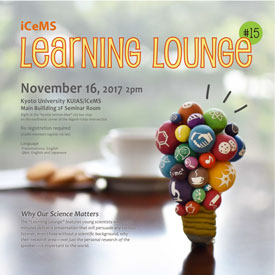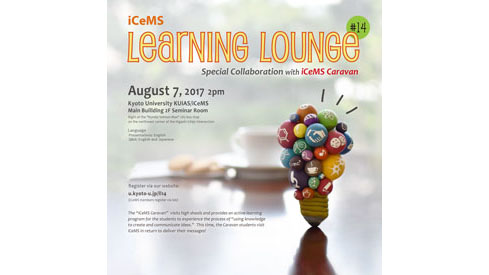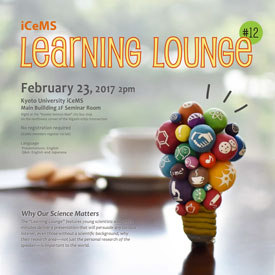iCeMS Learning Lounge #5: Hirotaka Nakatsuji + Ikumi Oomoto, 2015
Seeing is believing; what happens in the brain? Ms. Ikumi Oomoto
Course Description
Why Our Science Matters
The “Learning Lounge” features young scientists who, in 20 minutes deliver a presentation that will persuade any curious listener, even those without a scientific background, why their research area — not just the personal research of the speaker — is important to the world.
Mr. Hirotaka Nakatsuji
Golden Rods & Guided Robots: Your ‘Nano Doctors’ Healing from Within
Drugs are advancing together with the medical science. Before the advent of modern medicine, we use medical plant and prayers. Nowadays we use chemically synthesized drugs or gene therapy agent. However, some things have not changed. Once the pill is popped, there are nothing we can do. Here, I will introduce our remote-controlled “drugs”, which can heal more effectively and properly.
Our laboratory is focusing on biological application of light-responsive nanomaterials, like the materials used for solar cells. In our nerve cells, there are pain receptors called TRPV1, which responds to heat, acid and capsaicin (the pungent substance in chili peppers). In this talk, I introduce my research about controlling heat-sensitive pain receptor TRPV1 with light, by using nanomaterials which absorb light and generate heat. This time’s talk is only based on the experiments with cultured cells, but if we apply this method in our body, we might become able to control pain with light in the future.
Ms. Ikumi Oomoto
Decoding the Keys of Our Life Cycle
When we receive an idea or learn a new song, what needs to happen in our brain? To find the answer, it is best to “see” it. I will talk about a novel technique to “light-up” and “see” the changes in a brain upon learning.
In Wang group, we have developed a new imaging method to monitor RNA dynamics in living animal brains with the goal to understand molecular mechanism of learning and memory. Our strategy is to decrease fluorescence background noise in order to better detect signals and thus to get clear images. Though there are many steps to take before we can achieve imaging of learning-triggered RNA dynamic changes in a living animal, I enjoy taking one step forward everyday to solve the scientific mystery.
Details
- Year/Term
- 2015
- Date
- February 25th, 2016
- Faculty/
Graduate School - Institute for Integrated Cell-Material Sciences (iCeMS)
- Language
- Japanese, English
- Instructor name
- Mr. Hirotaka Nakatsuji(iCeMS Tatsuya Murakami Lab)
Ms. Ikumi Oomoto(iCeMS Dan Ohtan Wang Lab)
- Place
- 2nd floor Seminar Room, iCeMS Main Building, Kyoto University
Related Courses
 Course
Course
Motonari Uesugi
Institute for Chemical Research, Institute for Integrated Cell-Material Sciences (iCeMS)
 Public Lecture
Public Lecture
Dr. Satoshi Horike, Dr. Partha Chowdhury
Institute for Integrated Cell-Material Sciences (iCeMS)
2017 Public Lecture
Public Lecture
Students from Aizu Gakuho High School, Mr. Tomomichi Kato
Institute for Integrated Cell-Material Sciences (iCeMS)
2017 Public Lecture
Public Lecture
Dr. Yousuke Katsuda, Ms. Saki Fukuoka
Institute for Integrated Cell-Material Sciences (iCeMS)
2016


